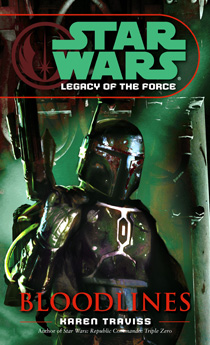On one hand, it seems unlikely that “The Force Awakens” screenwriters Lawrence Kasdan and J.J. Abrams read the “Legacy of the Force” series. But on the other hand, Jacen Solo’s arc in “Bloodlines” (2006) is so starkly re-enacted by Kylo Ren that it can’t be coincidence – if only because the idea of killing a loved one in order to gain power is such a specifically illogical idea.
In Disney’s “Episode VII,” Ren kills his father, Han Solo, driven by a vague belief that killing off the last of his own humanity will give him full access to dark-side power. Toward the end of “Bloodlines,” Jacen – with prompting from his mentor, Lumiya – decides that the central flaw in Darth Vader’s inability to bring peace to the galaxy was that he loved Padme. Since Jacen feels he is following Vader’s path (because he IS; he commits murder in cold blood several times through the first two books, including a defenseless prisoner in interrogation), he wonders how he can differentiate himself from his grandfather. He decides killing his lover, Tenel Ka, and daughter, Allana, will differentiate him, and that’s his mission for upcoming books.
By being different from Vader, Jacen thinks he’ll be able to bring a peaceful form of order to the galaxy, different from Vader’s failed attempt at order. The fact that Jacen’s strategy makes no logical sense – but that he thinks it does – is one of many reasons why Karen Traviss’ “Bloodlines” is a tough read, even though it has few flaws from a literary or even a page-turning perspective. Whereas Ren is a cipher in “Force Awakens,” Traviss lets us into the mind of Jacen, and we feel just as sick inside as Han and Leia do when they realize their son has become a monster. The “New Jedi Order” is often labeled as “dark” because of the deaths of Chewbacca and Anakin Solo, but “Legacy of the Force” explores a whole ‘nother level of pain and discomfort; if Jacen had merely died, it would be much easier for his parents to take than watching him turn into someone they don’t recognize.
The biggest criticism of “Legacy of the Force” and its follow-up series, “Fate of the Jedi,” is that “Star Wars” begins to resemble present-day Earth culture and politics too much. George Lucas often used the saga to comment on the real world, particularly in “Episode III” when Palpatine declares emergency powers, but some fans felt the balance between social commentary and escapism skewed too far toward the former in these novels.
This storytelling approach really kicks into gear in “Bloodlines” as Traviss draws a stark post-9/11 America parallel. In addition to the creation of a secret police, elimination of privacy protections and the policy of internment (the latter goes beyond even what the U.S. government has done so far), “Bloodlines’ ” Galactic Alliance also has an Earth feel – rather than a futuristic sci-fi feel — in specific ways. A bomb blows up at a building on Coruscant rather than, say, at a space depot. A lot of conversations take place in plain ol’ apartments (granted, this happens in the prequels, also), rather than spaceships or exotic military bases.

I remember from my first read that the civil war just kind of happens in “Legacy of the Force” without any good reason. This still holds true on my second read: It’s frustrating to see the Galactic Alliance go to war with Corellia basically because everyone in power says war is inevitable, even if they don’t want it. I’m not sure if Traviss is simply portraying the way politicians behave or if she is accidentally creating shallow characters; at any rate, it’s both a fair portrayal of reality and a frustrating one.
If both sides truly do to not want war, the solution might be this: The GA draws up a bill of what Corellian System owes for the money it borrowed to pay for post-Vong-war reconstruction (as referenced briefly in “Betrayal”), then allows it to peacefully secede from the GA. An arbitrator could be brought in to work out the details of the bill and the secession. Then the two separate governments can form treaties and arrangements, similar to what Great Britain and the European Union will be doing. None of the GA leaders propose this idea – even Luke throws up his hands when asked for a solution other than Jacen’s strong-arm tactics – which is irksome.
“Bloodlines” gives a textbook portrayal of blowback, even though the word is not used; and perhaps, as in the United States, the leaders of the GA might deny blowback exists as an inevitable psychological phenomenon that leads to a cycle of violence. Heading the newly formed Galactic Alliance Guard – the (not-so-)secret police – Jacen rounds up and interns Corellian citizens on Coruscant. As such, what started off as 1 percent of the Corellian population being terrorist threats turns into most of the Corellian population loathing the Alliance and seeing it as the enemy.
In “Bloodlines,” everyone – except Han and Leia, and possibly Luke — is a villain to some degree, and no one knows they are a villain. Even Jaina Solo participates in a blockade of Corellia, telling her father that she’s just doing her job. Ben Skywalker, 13, turns in an angry Corellian kid of the same age. Several GAG members disapprove of Jacen’s methods but don’t do anything about it; as Captain Shevu tells Ben, “Jacen’s my commanding officer” – in other words, it’s not his place to criticize him. Of course, Jacen faces no legal repercussions for killing the prisoner. “Bloodlines” does not directly note that this is an example of how a security state quickly becomes indistinguishable from an oppressive state, but of course it is.
Ben, Jacen’s apprentice, begins to doubt his hero when he sees the corpse of the woman he killed, but he figures Jacen must be doing something right, because he’s still allowed to do it. This is a good example of how the idea of the “rightness” of state violence permeates culture through the generations. But more specifically, I like how Traviss bounces these concepts of right and wrong around Ben’s mind; he’s getting deeper characterization than Jacen, Jaina and Anakin did at the same age. I hope future “Legacy of the Force” books find Ben – who kills someone for the first time in “Bloodlines” — conversing more with his mom about the morally questionable acts Mara committed in her own past as the Emperor’s Hand.
The prisoner that Jacen kills is Ailyn Habuur, Boba Fett’s daughter, and this is how the civil war plot links with “Bloodlines’ ” relatively breezier plot – the long-overdue return of Fett to the narrative of the novels. In fact, this is the meatiest Fett novel so far. Even though he’s 71, this is the first time we really get inside his head and get a feel for this lonely man.
Intriguingly, Traviss ties Fett into her own “Republic Commando” saga in a way similar to how “The Clone Wars” and “Rebels” connect – there’s a big gap in the narrative, but we gradually get more pieces of the story as the saga unfolds. Fett is searching for a clone who ages at a normal rate, thinking this man’s health records might be valuable in Fett’s own quest to fight off his terminal illness. Also out there is Kad’ika, known to be a product of Kal Skirata’s makeshift family of clones.
In “Bloodlines,” it’s a blast to see Fett and Han Solo team up – along with Mirta Gev, who it turns out is Fett’s granddaughter – to assassinate Thrackan Sal-Solo. I found it interesting that Han is hesitant to kill his cousin, even though Thrackan has a long career as a sleazebag criminal/politician and had several times attempted to kill Han. Apparently he has mellowed with age, because when it comes to self-defense, Han hadn’t hesitated in the past – see Greedo, but also the poor shmo he blasts out of the Falcon’s airlock in “Han Solo at Stars’ End.”
Han’s hesitation (even if the correct decision is to kill Thrackan) shows that he has more of a moral compass than Jacen and the GA’s leadership at this point. Jacen believes in the concept of “necessary evil” and in extending the notion of self-defense and pre-emptive attack to the point that it’s indistinguishable from aggression. Such actions aren’t just morally wrong, they are also strategically wrong.
When “Bloodlines” concludes, the galaxy is about to go to war with itself; Jacen doesn’t ever realize that his own actions have contributed to the situation. He’s a much more thoughtful Force user than, say, Anakin Skywalker or Kylo Ren, but only in the sense that Traviss allows us access to Jacen’s thoughts. He’s not necessarily any smarter. He’s a villain I hate, but I don’t love to hate him. He thinks “motive matters” because “motive is all there is to distinguish between good and evil” (p. 375), and that because he doesn’t desire power (he desires peaceful order), his motive is good. The major flaw in Jacen’s philosophy is the underlying assumption that peaceful order is 1) possible and 2) desirable. None of the other characters challenge him on these points; again, I’m not sure if that’s Traviss’ commentary-by-omission or if the author herself subscribes to the status-quo belief in “order.”
Jacen’s arrogance makes him as bad as any evil-doer throughout real-world history who thinks they are doing a small evil to prevent a bigger evil. That might be what Traviss is going for, but that doesn’t make it any more satisfying to read about his descent.

